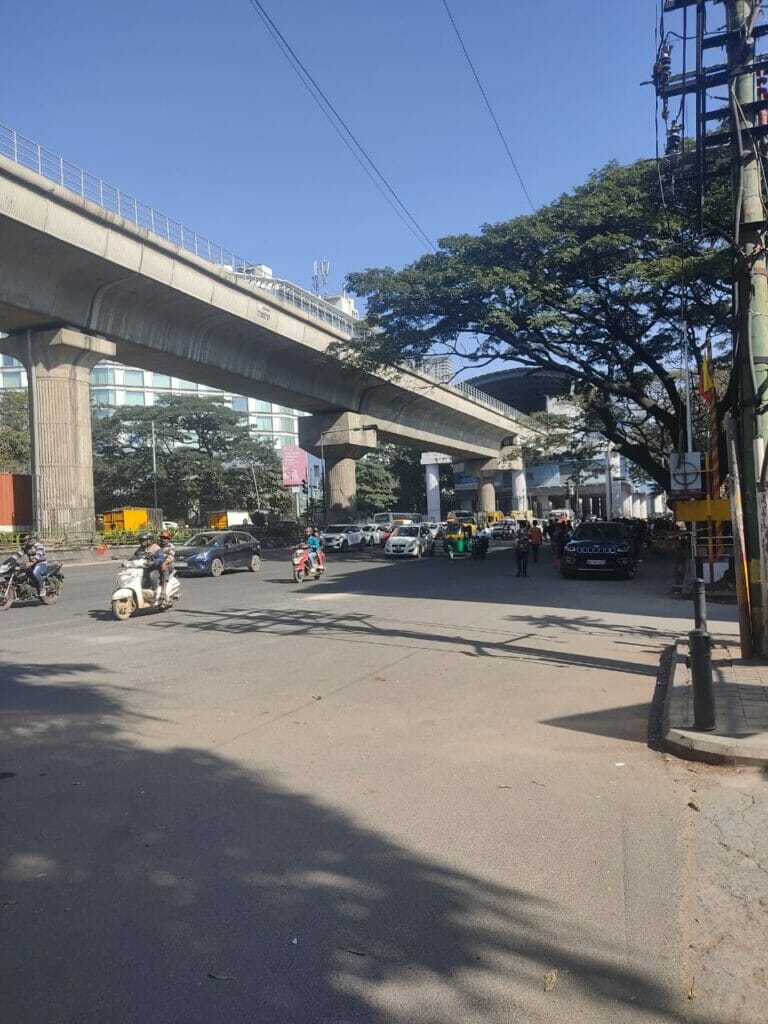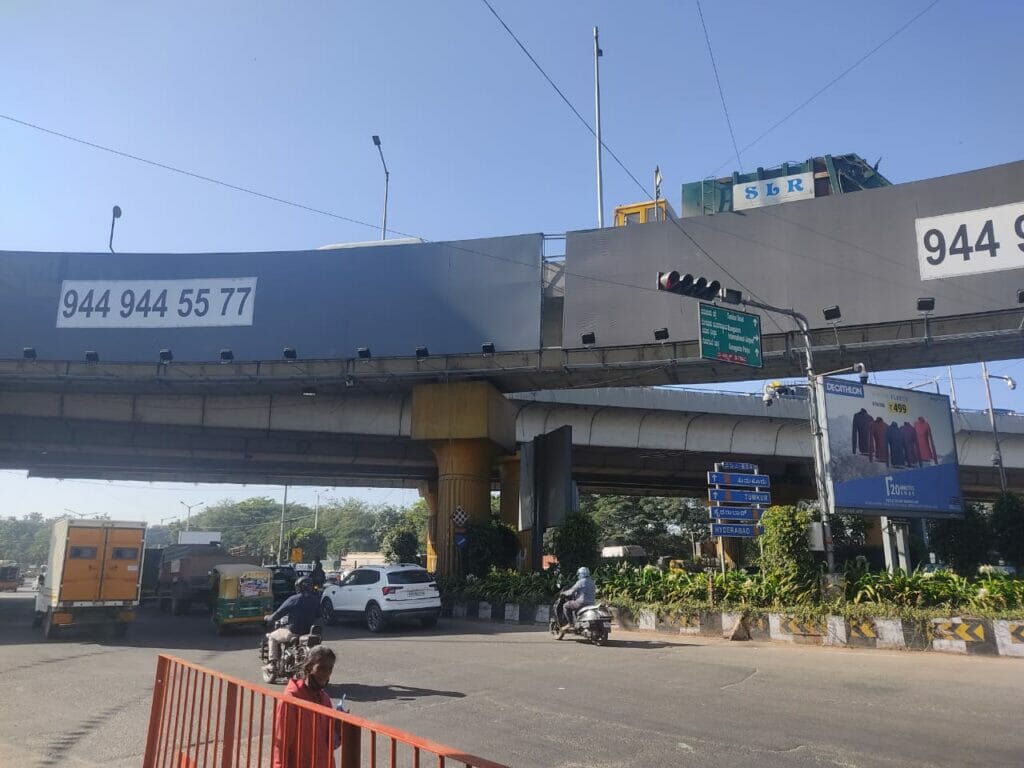I remember a story my uncle once told me. He was working in an IT office in Whitefield, and his team was scheduled to have an office meeting one morning. But that morning the boss asked if the meeting could be held online as that they were all stuck in the same traffic jam.
I am reminded of this anecdote every time I get stuck in traffic in Bengaluru, which is often. Since my uncle’s time, traffic snarls in the city have only worsened, forcing the government to finally step in to improve vehicular movement on the roads.
Reportedly reacting to complaints of poor traffic management from important visitors, who attended the investors’ meet in Bengaluru last year, the state government held a high-level meeting in November 2022 to decongest ten major traffic bottlenecks in the city. M.A. Saleem, the new police commissioner of traffic, was appointed to implement this task.
The junctions identified were Silk Board, Iblur, Jayadeva, MM Temple Junction at Tin Factory, Hebbal, Goraguntepalya, Sarakki, K S Layout, Kadubeesanahalli, and Banashankari. M.A. Saleem and his team subsequently listed the various factors responsible for the traffic snarls in these junctions.
Read more: Exclusive: “Presently, our focus is on regulating traffic,” says M. A. Saleem
What they listed were the old, known culprits—poor quality roads pitted with potholes and poor traffic management. Issues that Chief Minister Basavaraj Bommai assured will be taken up on a priority basis with enough funds allocated for the task.
Quick fix solutions
A 2020 study by TomTom, a Dutch location technology specialist, revealed that Bengaluru was the most traffic-congested city in the world. According to the study, commuters spend an extra ten days or 71% of travel time stuck in traffic each year.
Three years on and many internal meetings later, the internet continues its daily buzz from citizens stuck in a traffic jam. Perhaps not surprisingly, the traffic woes at some of these junctions escalated due to the construction of metro lines and flyovers.
Band-aid solutions were the first steps taken, like banning goods vehicles from using these roads from 7 am to 11 am and from 4.30 pm to 9 pm. Besides diverting some traffic to side roads. According to local area traffic police, the decision to ban the movement of heavy vehicles during peak hours has helped ease traffic.
Short and medium term plans like installing an intelligent traffic signalling system were also mentioned. Not much has been heard of such systems since.
The reality on the ground
I decided to visit three of the identified bottleneck junctions to understand the steps taken so far and assess to what extent, if any, they have helped to decongest traffic at those junctions.

The first junction I surveyed was the Goraguntepalya junction, which connects Outer Ring Road to Tumakuru road. There is a plush hotel to the right and a temple to the left that witness the rush of vehicles during peak hours. Adding considerably to the traffic snarl and the snail’s pace vehicular movement are a hospital nearby and the stop-start of BMTC buses at the stops on the roadside.
According to reports, the geography of the junction is apparently the reason for the traffic jams as it is close to the city’s border and connects 20 other districts.
But I noticed that even during non-peak hours, there is a lot of traffic movement in the area causing jams, which however do not last long.
The peak hour jam is just a pile of vehicles of all kinds on the road, unable to move. There is a constant line of vehicles waiting to enter and exit from the hospital nearby. The hotel close by also sees a constant inflow and outflow of vehicles that get stuck at the junction during peak hours. The emotions of the vehicle drivers ranged from bored resignation to animated gesturing and talking. Some of them had turned off their vehicles, knowing that the traffic was not going move anytime soon.
Once the signal turns green it is advised to cover your ears because loud and endless honking starts.
Pity the pedestrians
It is not just the vehicles but also a lot of pedestrian movement in the junction, with a bus stop on the side of the road, which sees a huge rush of people during peak hours waiting to board the bus. An interesting thing I noticed is that one bus conductor got down from his bus to have a quick bite, from a small roadside stall near the hospital, as he waited for traffic move.
And crossing the road is not easy for pedestrians, who have to weave their way through the rush of vehicles.
There were three or four traffic policemen trying to control the traffic as best as they could. But that hardly helped ease the jam. The traffic was slow moving and lasted for about an hour.
Banashankari junction
The next junction I observed was Banashankari, known as the busiest traffic intersection in South Bengaluru. There are seven roads cutting through this junction. And located nearby is the Banashankari Temple, Metro station, BMTC bus stand and a roadside market, all of which hinder efforts at decongesting the junction.
During peak hours it gets especially difficult as there are very few traffic policemen to regulate movement. Motorists can be seen jumping signals. It is risky for pedestrians to cross the congested junction. Some motorists stop to buy fruits and vegetables from the roadside stalls while waiting for traffic to ease. It seems almost as if the street vendors wait for traffic to stop as they receive more customers during that time.
I talked to a few people like Rakesh, who sells oranges by the roadside, if there has been any change in the traffic movement. “After metro work, the traffic has actually increased especially in the morning and evening,” says Rakesh. “There has not been much change in the past few months.”
An auto driver, who did not want to be named, said that traffic is more or less the same in the main big junction but the smaller junctions have even more traffic. According to a tweet by Kuldeep Kumar, DCP Traffic West Division, the police have removed a bus stop on the road towards Yarab Nagar that caused traffic jams at Banashankari. There was a plan to build a skywalk that connects the metro station and the bus stop but the project is yet to take off.
Read more: How to make Bengaluru traffic jams go away
Hebbal flyover junction
The third area I visited was the Hebbal flyover junction, one of the most talked about traffic bottlenecks in the city. There are multiple lanes converging into the two-lane flyover. The traffic jam in this place, at times, results in hours of waiting. The flyover and road below are both clogged with vehicles, throughout the day, only much more so during peak hours.
Several highways meet at this junction, and there seems to be no reduction in the number of vehicles. This junction sees a huge inflow and outflow of vehicles and pedestrians. There is a bus stop near the junction, which adds to traffic confusion.
As at the previous two junctions, this one was also a sea of honking vehicles trying to move a few feet, drivers getting restless, pedestrians risking life and limb trying to cross the roads. A serious road rage incident seemed just a honk away.
I spoke to one of the traffic police here who said that there has been no change in traffic. He said that the government is planning to build a new road to ease the traffic congestion. When asked about the decongestion techniques, he states that the ban on heavy vehicles during peak hours gives a little relief but the number of vehicles is so high that it still causes traffic jams.

There have been debates on how this traffic congestion can be eased. In July 2022, traffic was re-routed near the Hebbal flyover. Authorities banned vehicles entering the city from Yelahanka, Jakkur, Kodigehalli, and Kempapura from using the main road near Esteem Mall and instead use the service road at Hebbal junction towards KR Puram and climb onto the loop to head towards the city. But to little effect.
Cities like Jakarta and Bangkok, once notorious for traffic jams, have improved vastly over the years. The solutions they came up with drastically enhanced the citys’ public transport systems. Bengaluru, on the other hand, is still stuck on building more ring roads and flyovers. Public transport does not even enter the government’s thinking when it comes to managing the city’s traffic.
Vehicle statistics
According to government data, the number of vehicles in Bengaluru had increased from 50.33 lakhs in 2011-12 to 1.04 crores till March 2022. According to the city traffic police department, of the total vehicle density, two-wheelers account for 70%, 15% are cars, 4% are autos and the remaining are buses, vans, and tempos.